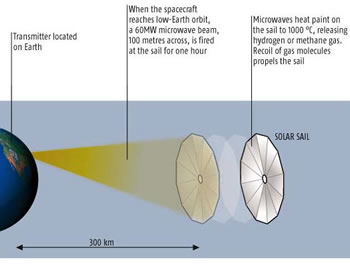Science Fiction
Dictionary
A B C D E F G H I J K L M N O P Q R S T U V W X Y Z
Earth To Mars In A Month With Painted Solar Sail

Gregory Benford, professor of physics at UC Irvine (and noted science fiction author) believes that a spacecraft powered by a special kind of solar sail could reach Mars in just one month.
Dr. Benford and his brother James were testing a very thin carbon-mesh sail, using microwaves as the energy source for propulsion. Unexpectedly, the sail experienced a force considerably greater than predicted. They theorized that the heat from the microwave beam was causing carbon monoxide gas to escape from the sail's surface; the recoil from the escaping molecules provided what could be a useful adjunct to the propulsive force experienced by light sails.
They believe that by beaming microwave energy up from Earth to boil off volatile molecules from a specially formulated paint applied to the sail will provide enough added force to propel a spacecraft to Mars in record time. "It's a different way of thinking about propulsion," Gregory Benford says. "We leave the engine on the ground." Their research will be published this month in the journal Acta Astronautica.

(From Carbon sail lifting against gravity under 5 kW microwave beam illumination.)
This is how it would work: a rocket would take the craft to low-Earth orbit, whereupon the craft would unfurl a 100 meter diameter sail. A transmitter on Earth would fire a one-hour burst of microwaves at it to heat it up, accelerating the craft to 60 kilometres per second. This would set an interplanetary speed record for space probes.

(From At 21,000 Km/hr, Mars is close.)
However, more work is needed to make this possible. The plan would require a 60-megawatt microwave beam with a similar diameter as the sail that was capable of tracking the craft. The deep-space communications network that NASA uses to communicate with Mars rovers and the Cassini probe now orbiting Saturn can only output half a megawatt.
If this design could work, it would make significant progress in the use of ground-based beam-propulsion designs. As science fiction readers know, this topic was explored in the 1974 novel Mote in God's Eye by Larry Niven and Jerry Pournelle. They used the idea of laser cannon from Robert L. Forward's 1961 paper Ground-Based Lasers For Propulsion In Space to bring an alien spacecraft to our solar system. Readers may also wish to explore early sf looks at solar sails.
Read a bit more about Gregory Benford; the article First Flight By A Laser-Powered Airplane chronicles an earlier effort at ground-based propulsion. See also Solar super-sail could reach Mars in a month and Acceleration of Sails by Thermal Desorption of Coatings (pdf).
Scroll down for more stories in the same category. (Story submitted 2/9/2005)
Follow this kind of news @Technovelgy.| Email | RSS | Blog It | Stumble | del.icio.us | Digg | Reddit |
Would
you like to contribute a story tip?
It's easy:
Get the URL of the story, and the related sf author, and add
it here.
Comment/Join discussion ( 9 )
Related News Stories - (" Space Tech ")
Will Space Stations Have Large Interior Spaces Again?
'They filed clumsily into the battleroom, like children in a swimming pool for the first time, clinging to the handholds along the side.' - Orson Scott Card, 1985.
Reflect Orbital Offers 'Sunlight on Demand' And Light Pollution
'I don't have to tell you about the seven two-mile-diameter orbital mirrors...'
Chrysalis Generation Ship to Alpha Centauri
'This was their world, their planet —
this swift-traveling, yet seemingly moveless vessel.' - Nat Schachner, 1934
The First Space Warship For Space Force
'Each of the electrical ships carried about twenty men...' - Garrett P. Serviss, 1898.
Technovelgy (that's tech-novel-gee!) is devoted to the creative science inventions and ideas of sf authors. Look for the Invention Category that interests you, the Glossary, the Invention Timeline, or see what's New.
Science Fiction
Timeline
1600-1899
1900-1939
1940's 1950's
1960's 1970's
1980's 1990's
2000's 2010's
Current News
The Zapata Air Scooter Would Be Great In A Science Fiction Story
'Betty's slapdash style.'
Thermostabilized Wet Meat Product (NASA Prototype)
There are no orbiting Michelin stars. Yet.
Could Crystal Batteries Generate Power For Centuries?
'Power could be compressed thus into an inch-square cube of what looked like blue-white ice'
India Ponders Always-On Smartphone Location Tracking
'It is necessary... for your own protection.'
Amazon Will Send You Heinlein's Knockdown Cabin
'It's so light that you can set it up in five minutes by yourself...'
Is It Time To Forbid Human Driving?
'Heavy penalties... were to be applied to any one found driving manually-controlled machines.'
Replace The Smartphone With A Connected Edge Node For AI Inference
'Buy a Little Dingbat... electropen, wrist watch, pocketphone, pocket radio, billfold ... all in one.'
Artificial Skin For Robots Is Coming Right Along
'... an elastic, tinted material that had all the feel and appearance of human flesh and epidermis.'
Robot Guard Dog On Duty
I might also be thinking of K-9 from Doctor Who.
Wearable Artificial Fabric Muscles
'It is remarkable that the long leverages of their machines are in most cases actuated by a sort of sham musculature...'
BrainBridge Concept Transplant Of Human Head Proposed
'Briquet’s head seemed to think that to find and attach a new body to her head was as easy as to fit and sew a new dress.'
Google's Nano Banana Pro Presents Handwritten Math Solutions
'...copy was turned out in a charming and entirely feminine handwriting.'
Edible Meat-Like Fungus Like Barbara Hambly's Slunch?
'It was almost unheard of for slunch to spread that fast...'
Sunday Robotics 'Memo' Bot Has Unique Training Glove
'He then started hand movements of definite pattern...'
Woman Marries Computer, Vonnegut's Dream Comes True
'Men are made of protoplasm... Lasts forever.'
Natural Gait With Prosthetic Connected To Nervous System
'The leg was to function, in a way, as a servo-mechanism operated by Larry’s brain...'
